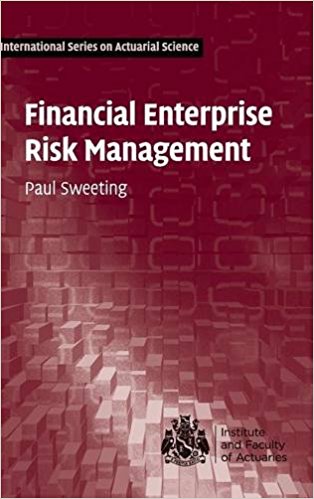 Author: Paul Sweeting
Author: Paul Sweeting
Publisher: Cambridge University Press – 551 pages
Book Review by: Deekay Daulat
There are always many types of risks involved in starting, growing, and managing a business, as any business owner will tell you. The danger of not only not making any money on the money you have invested, but also losing some or all your money (and then some) is always ever-present. Sometimes the risk is beyond financial: it may be the risk of losing your good reputation, which is more valuable in the long run than money.
This is a fairly comprehensive book on managing various risks in a financial enterprise, spanning over 550 pages. It looks at what could go wrong and how it could go wrong. It looks at potential risk from many angles, including some that probably never crossed your mind as you began your enterprise, or are now managing one of your own or someone else’s.
As we often do, because we think it is important, we present an overview of what you will (and will not) find in a given book by simply listing the titles of the chapters. So these are the titles of the 20 chapters of this work:
- An introduction to enterprise risk management
- Types of financial institutions
- Stakeholders
- The internal environment
- The external environment
- Process overview
- Definitions of risk
- Risk identification
- Some useful statistics
- Statistical distributions
- Modeling techniques
- Extreme value theory
- Modeling time series
- Quantifying particular risks
- Risk assessment
- Responses to risk
- Continuous considerations
- Economic capital
- Risk frameworks
- Case Studies
This book has been developed for these and other groups of people:
- Actuarial students preparing for examinations
- Practitioners in risk management
- Academics looking to learn about the latest updates on current technologies in this area
- Anyone wanting to know more about this subject.
Among other aspects of risk management of financial enterprises, this book:
- Provides all the tools needed to build and maintain a comprehensive enterprise risk management (ERM) framework
- Outlines the construction of such frameworks
- Discusses the internal and external contexts within which risk management must be carried out
- Covers a range of qualitative and quantitative techniques that can be used to identify, model, and measure risks, and describes a range of mitigation strategies
- Describes the range of risk management approaches available, with over 100 diagrams
- Highlights risk management issues with various case studies
- Illustrates a number of proprietary, advisory, and mandatory risk management frameworks, including solvency II, Basel III, and ISO 31000:2009
The author Paul Sweeting writes that this book began as sessional paper presented to the Institute of Actuaries in Manchester, England, and a few months later, to the Faculty of Actuaries in Edinburgh. At about that time, the subject of enterprise risk management was being added to the UK actuarial examinations.
So it was timely to expand the paper into something substantial. So he provided detailed information on the various technologies that were simply mentioned in the initial work.
This book was published in 2011, a time of crisis for financial institutions around the world, who were blamed for easy lending to unqualified borrowers. Paul Sweeting writes in the Preface:
“Financial models have been blamed for a large part of the crisis, and this criticism is, to an extent, well-founded. It is certainly tempting to place far too much reliance on very complex models, ignoring the fact that they merely represent, rather than replicate the real world. Some senior executives have also been guilty of seeing the output of these models but not understanding the underlying approaches and their limitations”
Probably the most important point he makes at the outset of this book is that all potential risks should be taken into account that make have adverse effects when managing an enterprise.
This is an excellent book on risk management in a financial enterprise and we highly recommend that it be thoroughly read and understood. Its coverage is well thought-out and quite extensive.
Author:
Paul Sweeting is a Managing Director at JP Morgan Asset Management. Prior to this he was Professor of Actuarial Science at the University of Kent and he still holds a chair at the university. Before moving to academia, Paul held a number of roles in pensions, insurance, and investment. Most recently he was responsible for developing the longevity reinsurance strategy for Munich Reinsurance, before which he was Director of Research for Fidelity Investments’ Retirement Institute.
In his early career, Paul gained extensive experience as a consulting actuary advising on pensions and investment issues for a range of pension schemes and their corporate sponsors. He is affiliated with a number of professional bodies being Fellow of the Institute of Actuaries, a Fellow of the Royal Statistical Society, a Fellow of the Securities and Investment Institute, and a CFA Charterholder. Paul has written extensively on a range of pensions, investment and risk issues and is a regular contributor to the print and broadcast media.







